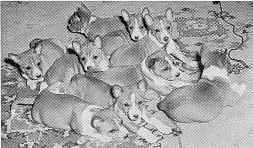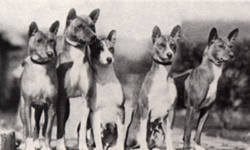
I have just received a letter from the Standard Committee of the BCOA which says: "As you
know the present Standard under which our breed is judged was approved in 1954. While fashions
in dogs don't change as rapidly as skirt lengths, there are evolutionary changes which take place
over the years which sometimes must be recognised as desirable or rejected by being shown as a
fault. "
I very much agree with this, and it brings to mind another aspect of the situation which is that
certain points were known and admired in the original imports of the 1930's, but which, over the
years, have gradually disappeared so that present day newcomers to the breed almost look upon
them as peculiarities. I refer in particular to ears and short muzzles. The original dogs all had small,
rather rounded ears, and the skull from the top of the head to the stop was quite a bit longer than
from the stop to the tip of the nose. This gave both charm and type to the head, and I think most
people would admit that a Basenji with small ears and a short muzzle is far more aristocratic than a
dog with large ears, particularly if they are not well carried, and a long muzzle.
But, here's the snag. About three years ago, I sent a five-month old puppy to New Zealand,
and his new owner wrote that she was delighted with everything about him except his short muzzle!
She added she had never seen a short muzzle like his and all the current Basenjis in New Zealand
had long muzzles. I think this had come about by shortage of stock, which resulted in in - breeding
to a long muzzled 1ine. I explained that the short nose was correct and that the English Standard,
1961, stated, "The distance from the top of the head to the stop is slightly more than from the stop
to the tip of the nose." She afterwards wrote that she much preferred the short muzzle and as the
dog became the top stud dog of New Zealand and Australia, he has done much to bring back the
desired short muzzle.
It is the same with ears. As the photo shows the old stock of nearly 30 years ago, all had
small, rounded ears. It used to be described as "looking like a cat's ears when viewed from the
back." This, alas, cannot be said of the present day stock, in fact, with some, a donkey's ears would
be appropriate description. It has reached the stage when some breeders saw a dog with the orig-
inal small ears and were amazed, feeling that the ears had been trimmed! In fact, they looked upon it
as a fault instead of a faint ray of hope that small ears could be brought back.

It is interesting to see that in the group of five dogs in the above photo from left to right,
K'IMPI, KWANGO, KOOKOO, KASUI and KAVIRONDO OF THE CONGO, that
KAVIRONDO has the largest ears. She was sired by Mrs. Burn's import, BUNGWA OF
BLEAN. Mrs. Burn never cared for BUNGWA, feeling his ears were too large giving him a "village
dog" appearance and shortly after this she removed him from stud. I feel this was the beginning of
large ears creeping into the breed, but even so, we needed the new blood and several good points
were contributed by BUNGWAMrs. Cardew knew the original stock, and when she saw FULA she said, "Oh, she has the
little short face and small ears, she is like a long legged AMATANGAZIG, what a pity her
photos make her ears look bigger, " so on the left, I am including an amateur snap to show
these.
I think the situation over the length of muzzle is safe Most people prefer the short muzzle and
there are enough around to ensure they are preserved. But I fear the small ears are a different
matter. They are the exception rather than the rule, and I begin to wonder whether climate might
have something to do with making the ears grow bigger and it could be called an evolutionary
change referred to in the first paragraph. This is rather a tragedy, as the small, high set, crisp ear of
the Basenji was so typical and contrasted so strongly with the "pi-dogs" and the village dogs which I
have seen in Africa from Port Sudan in the East, to Senegal in the West, and which have large ears,
usually low set and very poorly carried. All we can do is bear in mind that the small ear was the
original ideal and use it whenever possible in breeding programs. The English Standard, 1961, lists
among faults, "Ears too low set and too large. "
By mentioning these two points, I am not decrying the progress of Basenjis. In almost every
other way, I think they have improved enormously in recent years, particularly in better length of leg,
curlier tails and better tail sets, and temperament too seems to be greatly improved.
Reprinted from
The Basenji
Volume V Number 11 November 1968 p. 18
Copyright © 1968 The Basenji, All
Rights Reserved.
Used
with permission.